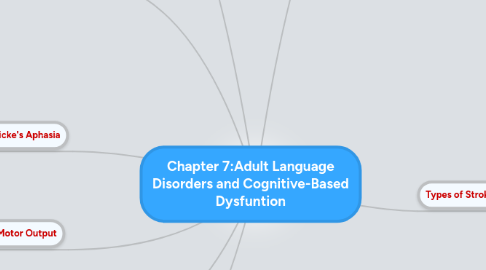
1. How is Aphasia Classified?
1.1. The classification system for the aphasia's is known as taxonomy.
1.1.1. Taxonomy: Draws upon those characteristics of aphasia that most differentiate disorders from one another and is similar to the way we might classify automombiles
2. Naming
2.1. Anomia
2.1.1. "no name" is the term used to describe word-finding problems or the inability to retrieve a word.
2.2. Paraphasias
2.2.1. Anomia patterns are the type of word production errors seen in a person with aphasia, these patters are called paraphasia, they come in two varieties
3. Fluency and Motor Output
3.1. Prosody
3.1.1. Refers to the melody, intonation, and rhythm of speech (Utterances is not affected)
3.2. Logorrhea
3.2.1. People with Wernicke's aphasia may appear verbose or may talk excdssively
4. Wernicke's Aphasia
4.1. Results from brain injury to he superior and posterior regions of the temporal lobe. It is a syndrome that is fluent, reception, and sensory aphasia.
5. Dementia
5.1. A chronic and progressive decline in memory, cognition, language, and personality resulting from central nervous system dysfunctiong
5.1.1. Alzheimers Disease
5.1.2. Huntington's Disease
5.1.3. Parkinson's Disease
5.1.4. Pick's Desease
5.1.5. Creutzfeldt-Jakob
5.2. 1.
5.2.1. Memory Impairment (both short- and long-term memory)
5.3. 2.
5.3.1. Impairment in cognitive skills (abstract thought, judgment, and executive functions)
5.4. 3.
5.4.1. Presence of aphasia, apraxia, or agnosia (inability to recognize objects, words, or sounds)
6. Fluency
6.1. A qualitative aspect of communication and speech that is used to describe its forward flow, including its phrasing, intonation, and rate.
6.1.1. Fluent speech is easy, smooth ,and well paced
6.2. Nonfluent
6.2.1. Short, choppy phrases
6.2.2. Slow, labored production of speech
6.2.3. Grammatical errors
6.2.4. Telegraphic quality
7. Aphasia
7.1. A Language disorder that is acquired sometime after an individual has developed
7.1.1. 1.
7.1.1.1. A disturbance in the language system after language has been established or learned.
7.1.1.2. 2.
7.1.1.2.1. Results from neurological injury to the language-dominant hemisphere of the brain
7.1.1.2.2. 3.
7.2. Dysarthria
7.2.1. A motor speech disorder characterized by disruption in the range, speed, direction, timing, and strength of movements in the respiratory, phonatory, articulatory, or resonatory componenets of speech.
7.3. Apraxia
7.3.1. Another motor speech disturbance, is a difficulty in planning and executing the volitional movements of speech.
7.3.1.1. Language-based, not a motor based, dysfunction.
8. Types of Strokes
8.1. Ischemic Strokes
8.1.1. When the blood supply to the brain is inhibited becaue of an occlusion (blockage) somewhere in an artery
8.2. Thrombosis
8.2.1. Occurs when plaque builds up in an artery and eventually closes it off, prohibiting the flow of blood.
8.3. Embolism
8.3.1. Occurs when a piece of accumulated plaque breaks of f of an artery and then migrates from larger arteries into smaller arteries when it ultimately will lodge, blocking the flow of blood
8.4. Hemorrhagic Strokes
8.4.1. Occurs when a blood vessel or artery ruptures and excessive amounts of blood enter the brain
